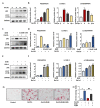Exercise Ameliorates Atherosclerosis via Up-Regulating Serum β-Hydroxybutyrate Levels
- PMID: 35409148
- PMCID: PMC8998237
- DOI: 10.3390/ijms23073788
Exercise Ameliorates Atherosclerosis via Up-Regulating Serum β-Hydroxybutyrate Levels
Abstract
Atherosclerosis, accompanied by inflammation and metabolic disorders, is the primary cause of clinical cardiovascular death. In recent years, unhealthy lifestyles (e.g., sedentary lifestyles) have contributed to a worldwide epidemic of atherosclerosis. Exercise is a known treatment of atherosclerosis, but the precise mechanisms are still unknown. Here, we show that 12 weeks of regular exercise training on a treadmill significantly decreased lipid accumulation and foam cell formation in ApoE-/- mice fed with a Western diet, which plays a critical role in the process of atherosclerosis. This was associated with an increase in β-hydroxybutyric acid (BHB) levels in the serum. We provide evidence that BHB treatment in vivo or in vitro increases the protein levels of cholesterol transporters, including ABCA1, ABCG1, and SR-BI, and is capable of reducing lipid accumulation. It also ameliorated autophagy in macrophages and atherosclerosis plaques, which play an important role in the step of cholesterol efflux. Altogether, an increase in serum BHB levels after regular exercise is an important mechanism of exercise inhibiting the development of atherosclerosis. This provides a novel treatment for atherosclerotic patients who are unable to undertake regular exercise for whatever reason. They will gain a benefit from receiving additional BHB.
Keywords: ABCA1; ABCG1; BHB; SR-BI; atherosclerosis; autophagy; exercise; foam cell formation.
Conflict of interest statement
The authors declare no conflict of interest.
Figures






Similar articles
-
Homocysteine accelerates atherosclerosis via inhibiting LXRα-mediated ABCA1/ABCG1-dependent cholesterol efflux from macrophages.Life Sci. 2018 Dec 1;214:41-50. doi: 10.1016/j.lfs.2018.10.060. Epub 2018 Oct 28. Life Sci. 2018. PMID: 30393020
-
Dihydromyricetin ameliorates foam cell formation via LXRα-ABCA1/ABCG1-dependent cholesterol efflux in macrophages.Biomed Pharmacother. 2018 May;101:543-552. doi: 10.1016/j.biopha.2018.02.124. Epub 2018 Mar 22. Biomed Pharmacother. 2018. PMID: 29505925
-
Nucleolin protects macrophages from oxLDL-induced foam cell formation through up-regulating ABCA1 expression.Biochem Biophys Res Commun. 2017 Apr 29;486(2):364-371. doi: 10.1016/j.bbrc.2017.03.047. Epub 2017 Mar 14. Biochem Biophys Res Commun. 2017. PMID: 28315324
-
Foam cells in atherosclerosis.Clin Chim Acta. 2013 Sep 23;424:245-52. doi: 10.1016/j.cca.2013.06.006. Epub 2013 Jun 16. Clin Chim Acta. 2013. PMID: 23782937 Review.
-
ATP-binding cassette transporters A1 and G1, HDL metabolism, cholesterol efflux, and inflammation: important targets for the treatment of atherosclerosis.Curr Drug Targets. 2011 May;12(5):647-60. doi: 10.2174/138945011795378522. Curr Drug Targets. 2011. PMID: 21039336 Review.
Cited by
-
Inhibition of CX3CL1 by treadmill training prevents osteoclast-induced fibrocartilage complex resorption during TBI healing.Front Immunol. 2024 Jan 12;14:1295163. doi: 10.3389/fimmu.2023.1295163. eCollection 2023. Front Immunol. 2024. PMID: 38283363 Free PMC article.
-
Exercise in Diabetic Nephropathy: Protective Effects and Molecular Mechanism.Int J Mol Sci. 2024 Mar 23;25(7):3605. doi: 10.3390/ijms25073605. Int J Mol Sci. 2024. PMID: 38612417 Free PMC article. Review.
-
The Roles of Aerobic Exercise and Folate Supplementation in Hyperhomocysteinemia-Accelerated Atherosclerosis.Acta Cardiol Sin. 2023 Mar;39(2):309-318. doi: 10.6515/ACS.202303_39(2).20221027A. Acta Cardiol Sin. 2023. PMID: 36911543 Free PMC article.
-
Targeting protein modifications in metabolic diseases: molecular mechanisms and targeted therapies.Signal Transduct Target Ther. 2023 May 27;8(1):220. doi: 10.1038/s41392-023-01439-y. Signal Transduct Target Ther. 2023. PMID: 37244925 Free PMC article. Review.
-
Ketone Bodies and Cardiovascular Disease: An Alternate Fuel Source to the Rescue.Int J Mol Sci. 2023 Feb 10;24(4):3534. doi: 10.3390/ijms24043534. Int J Mol Sci. 2023. PMID: 36834946 Free PMC article. Review.
References
-
- Frodermann V., Rohde D., Courties G., Severe N., Schloss M.J., Amatullah H., McAlpine C.S., Cremer S., Hoyer F.F., Ji F., et al. Exercise reduces inflammatory cell production and cardiovascular inflammation via instruction of hematopoietic progenitor cells. Nat. Med. 2019;25:1761–1771. doi: 10.1038/s41591-019-0633-x. - DOI - PMC - PubMed
MeSH terms
Substances
Grants and funding
LinkOut - more resources
Full Text Sources
Medical
Molecular Biology Databases
Research Materials
Miscellaneous

